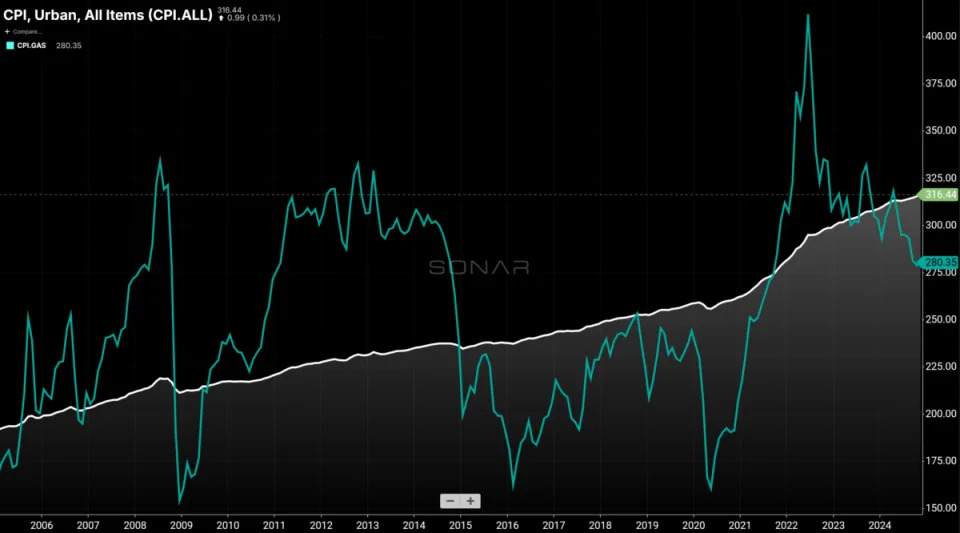News
December inflation data puts future Fed cuts to bed

In December 2024, U.S. consumer inflation reached an annual rate of 2.9%, largely driven by a surge in gas prices. The Consumer Price Index (CPI) ticked up 0.4% from November, in line with economists’ forecasts.
The core CPI — which excludes items with volatile pricing like food and energy — rose by 0.2% month over month (m/m), rounding out 2024 with a 3.2% year-over-year (y/y) increase. This data betrays persistent inflationary pressures that weigh on both the trucking industry and the Federal Reserve’s appetite to continue cutting interest rates.
Still too hot to trot
Though prices have risen globally since Russia’s invasion of Ukraine in February 2022, U.S. inflation has been a roller-coaster ride that peaked around 9% y/y growth in June 2022.

The initial spike was largely attributable to a surge in energy prices, but pandemic-induced supply chain disruptions and labor shortages both precipitated and sustained the U.S. inflation crisis. Of course, trillions of dollars of government spending under both the Trump and Biden administrations helped to inflame the crisis as well, though supporters argue that much of this spending staved off an economic depression
Despite aggressive interest rate hikes by the Fed aimed at curbing inflation, the CPI’s decline in yearly growth has been gradual and uneven.
While the Fed under Chairman Jerome Powell has made much ado about its data-dependent decision-making and determination to tame inflation, it cut rates by a cumulative 100 basis points in the final months of 2024 — even as inflation was threatening to rear its head once more.
That said, the Fed is also committed to the other half of its “dual mandate,” which is to both stabilize prices and secure maximum employment. [Technically, the Fed has a little-discussed “triple mandate,” which adds the condition of moderate long-term interest rates.]
Like a Weeble , the labor market appeared wobbly throughout much of 2024 but has yet to fall down.
The latest employment figures have reduced the likelihood of further rate cuts anytime soon, as the Fed focuses its cautious gaze on reigniting inflationary pressures. “With labor market data remaining robust, the Fed has less room to maneuver on rate cuts,” stated Dominic Wilson, senior adviser at Goldman Sachs in an analyst note. “The steady rise in core CPI suggests that inflation is not abating rapidly enough to warrant easing monetary policy without risking further price hikes.”
The great (supply) chain of being
The U.S. trucking industry is not unbothered by this miasma of persistent inflation. For one, rising diesel prices obviously increase operational costs for trucking companies, which should (in theory) drive rates higher.
But rising energy costs means different things to carriers of different sizes. Large, enterprise fleets with access to wholesale rack prices can bill shippers at the higher retail cost and pocket the difference. On the flip side, owner-operators in a competitive spot market often have little leverage to negotiate rates higher and thus have to eat the costs outright.
Additionally, inflation is a headwind for consumer demand — the engine behind three-quarters of the U.S. economy — which in turn affects the volume of goods hauled by trucks. The potential for sweeping policy changes under the incoming Trump administration, such as the raising and/or enactment of tariffs on imported goods, could further impact the trucking sector by dramatically reshaping supply chains.
In the end, consumer-driven truckload demand is indelibly linked to overall economic health and inflationary trends.
As inflation persists, consumer purchasing power may be curtailed, leading to decreased demand for non-essential goods. Weaker consumer demand can translate into lower truckload volumes, as was seen throughout much of the past few years. Conversely, essential goods and commodity transportation may remain robust, providing a counterbalance to divergent demand patterns.
For more insights on trucking industry dynamics and economic outlooks, subscribe to FreightWaves’ newsletters and stay updated with the latest trends and analyses.
The post December inflation data puts future Fed cuts to bed appeared first on FreightWaves .

